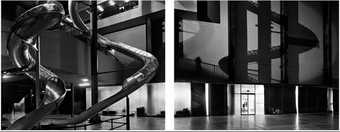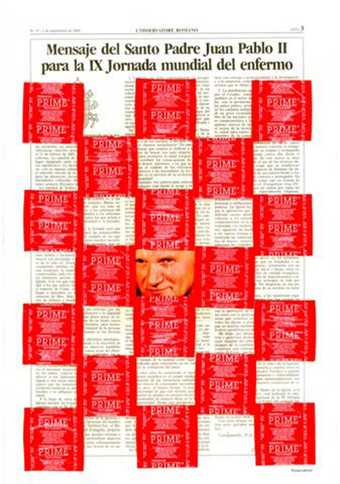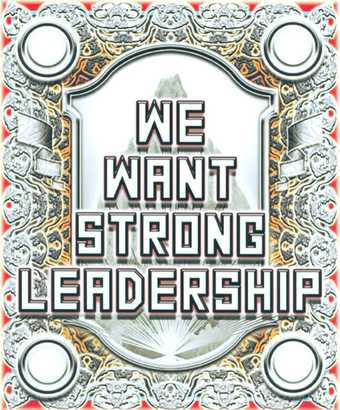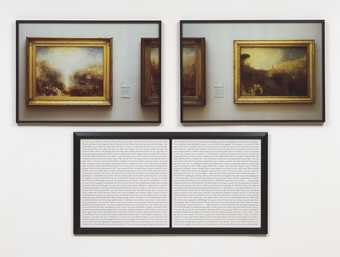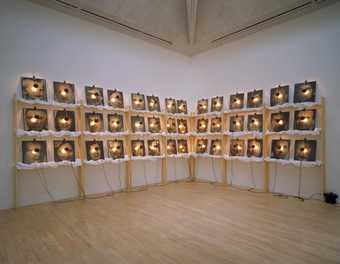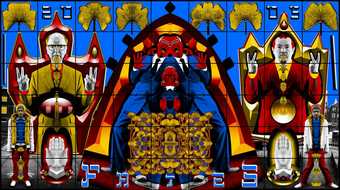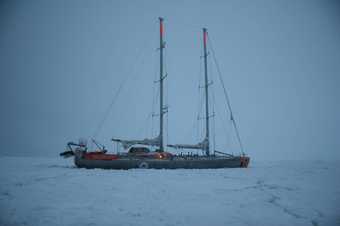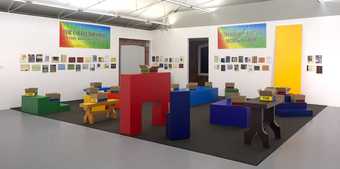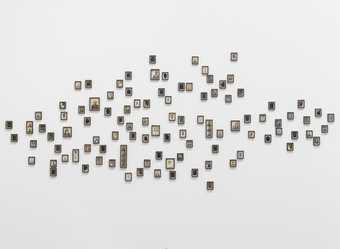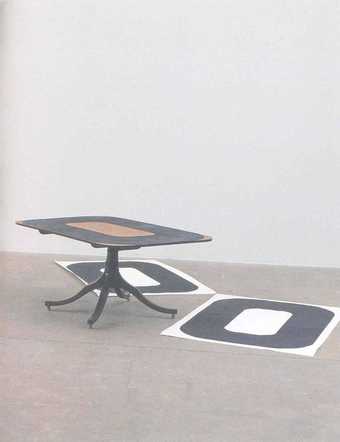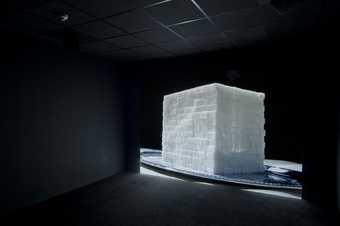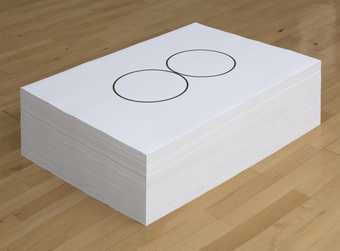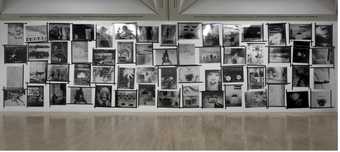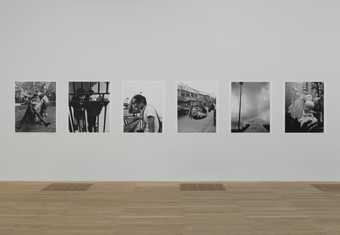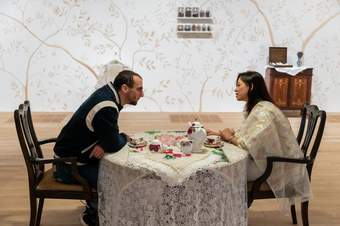In Tate Liverpool
- Artist
- Kader Attia born 1970
- Medium
- Cooked couscous on wooden table and digital prints on paper
- Dimensions
- Overall display dimensions variable
- Collection
- Tate
- Acquisition
- Purchased using funds provided by the Middle East North Africa Acquisitions Committee 2010
- Reference
- T13179
Summary
Untitled (Ghardaïa) 2009 is a scale model of the ancient city Ghardaïa in the M’zab Valley in Algeria. The model is made from cooked couscous, a staple food of North Africa, and sits on a wooden table or on the floor. The square and circular blocks cluster towards the centre of the terrain, which is marked by a tall tower. All the buildings comprise variations on simple geometric forms. The model is accompanied by three works on paper: portraits of the Swiss-French architect Le Corbusier (1887–1965) and of the French architect Fernand Pouillon (1912–1986) and a print out of the UNESCO Advisory Body Evaluation of the M’zab Valley as a world heritage site. These three digital prints unframed and are attached to the walls surrounding the sculpture. By bringing these elements together Kader Attia highlights a moment of cultural exchange between France and Algeria – specifically between the architects and the city that was their inspiration – which in turn parallels the artist’s personal history, as he was born in France to Algerian parents.
Untitled (Ghardaïa) reveals the influence of the East on the West, troubling the logic of colonial influence in which the coloniser dominates and degrades a native culture and civilisation. However, just as the work seems to celebrate the influence Ghardaïa has had on European Modernist architecture, it also evidences its precariousness. This is played out literally as the couscous crumbles and decays over the course of the installation, only to be refreshed when the structures become unrecognisable. But it is also suggested by the fixed gazes of the architects who look onto the model from the wall, as well as the world heritage accreditation, which signals the need for the city’s care and protection. Ultimately Untitled (Ghardaïa) poses questions about why the city is valued: whether it is because of its local history or its association with Western architecture.
The presence of the artist’s personal history is implied in the work by the reference to Pouillon, who designed some of the first social housing projects in France. Attia spent most of his childhood living in these buildings, which are known as banlieues. Pouillon was influenced by Le Corbusier, who incorporated many of the fundamental principles of Ghardaïa’s buildings, such as the roof terrace and the free façade, into his style after a visit to Algeria in 1931. Le Corbusier’s appropriation of parts of Algerian buildings for his construction of a modern architectural style highlights how the new can be comprised of the novel or the unfamiliar. Attia’s exposure of this contradiction relates to postmodernism and the analysis of how forms, styles and symbols circulate and signify differently in different contexts. The artist has reflected on this, explaining: ‘this influence [of East upon the West] leads us to think that the evolution of modern and post-modern aesthetics in architecture, like the influence of “Africanity” on Western modern art, calls for an ethical way of thinking about post-modern and post-colonial history’. He goes on to explain that while there is still a western-centric reading of colonialism, ‘the influence that exists between two cultures is never one way, but always two ways. That’s the same for the reading for signs of cultural appropriation, which seems to precede an evolution.’ (Kader Attia, ‘Signs of Re-appropriation’, artist’s statement, 2011, http://kaderattia.de/signs-of-reappropriation/, accessed 7 June 2016).
Untitled (Ghardaïa) is part of a larger project by the artist called Signs of Reappropriation, which explores the M’zab valley. Architectural models also feature in other works by Attia such as Kasbah 2009, an installation that depicts a typical shanty town, and Untitled (Concrete Blocks) 2008, a sculpture that likens social housing to concrete blocks that are positioned on the verge of collapse. Attia has explained his concern with architecture and the urban environment as follows:
architecture is an archive, and like any other archive it is ‘authoritarian’ because it excludes what it does not show and extols what it does show. But this authority has a vulnerability that art can reveal. And that’s what I try to do in my art.
(Attia in Huarte Contemporary Art Centre 2009, p.24.)
Further reading
Yves Aupetitallot and Thierry Prat (eds.), Kader Attia, exhibition catalogue, Musée Contemporain, Lyon 2008.
Hossein Amirsadeghi, Salwa Mikdadi and Nada Shabout (eds.), New Vision: Arab Contemporary Art in the 21st Century, London 2009, reproduced p.83.
Kader Attia, exhibition catalogue, Huarte Contemporary Art Centre, Navarra 2009.
Kyla McDonald
October 2009
Does this text contain inaccurate information or language that you feel we should improve or change? We would like to hear from you.
Display caption
On the table is a model, made entirely of couscous, of the ancient Algerian city of Ghardaïa. One of the photographs on the wall depicts the Swiss-French architect Le Corbusier, who visited Ghardaïa in 1931 and adapted elements of its buildings into his own designs. Another photograph shows Fernand Pouillon, one of Le Corbusier’s followers, who drew upon these ideas to design the social housing project in suburban Paris where Attia grew up, as the child of Algerian parents. The artist’s own history, and the wider post-colonial relationship between Algeria and France, are therefore expressed through this work.
Gallery label, October 2016
Does this text contain inaccurate information or language that you feel we should improve or change? We would like to hear from you.
Explore
- abstraction(8,615)
-
- from recognisable sources(3,634)
-
- man-made(999)
- townscapes / man-made features(21,603)
-
- building - non-specific(3,161)
- townscape(3,297)
- formal qualities(12,454)
-
- photographic(4,673)
- food and drink(980)
-
- couscous(1)
- individuals: male(1,841)
- social comment(6,584)
-
- commerce(93)
- globalization(28)
- inscriptions(6,664)
-
- printed text(1,138)
You might like
-
Matthew Pillsbury Slides in the Turbine Hall, Tate Modern, London, 2007
2007 -
León Ferrari [no title]
2001, reproduced 2007 -
Mark Titchner We Want Strong Leadership
2004 -
Sophie Calle Purloined (Turner)
1998–2013 -
Christian Boltanski The Reserve of Dead Swiss
1990 -
Gilbert & George Fates
2005 -
Pierre Huyghe A Journey that wasn’t
2005 -
Allen Ruppersberg The Never Ending Book
2007 -
Lorna Simpson Photo Booth
2008 -
Lucy Skaer Zero Table
2008 -
Kader Attia Oil and Sugar #2
2007 -
Felix Gonzalez-Torres “Untitled” (Double Portrait)
1991 -
Clunie Reid Your Higher Plane Awaits
2010 -
Birdhead (Ji Weiyu, born 1980; Song Tao, born 1979) Welcome to Birdhead World Again
2011 -
Yasmin Jahan Nupur Let Me Get You a Nice Cup of Tea
2019–20


